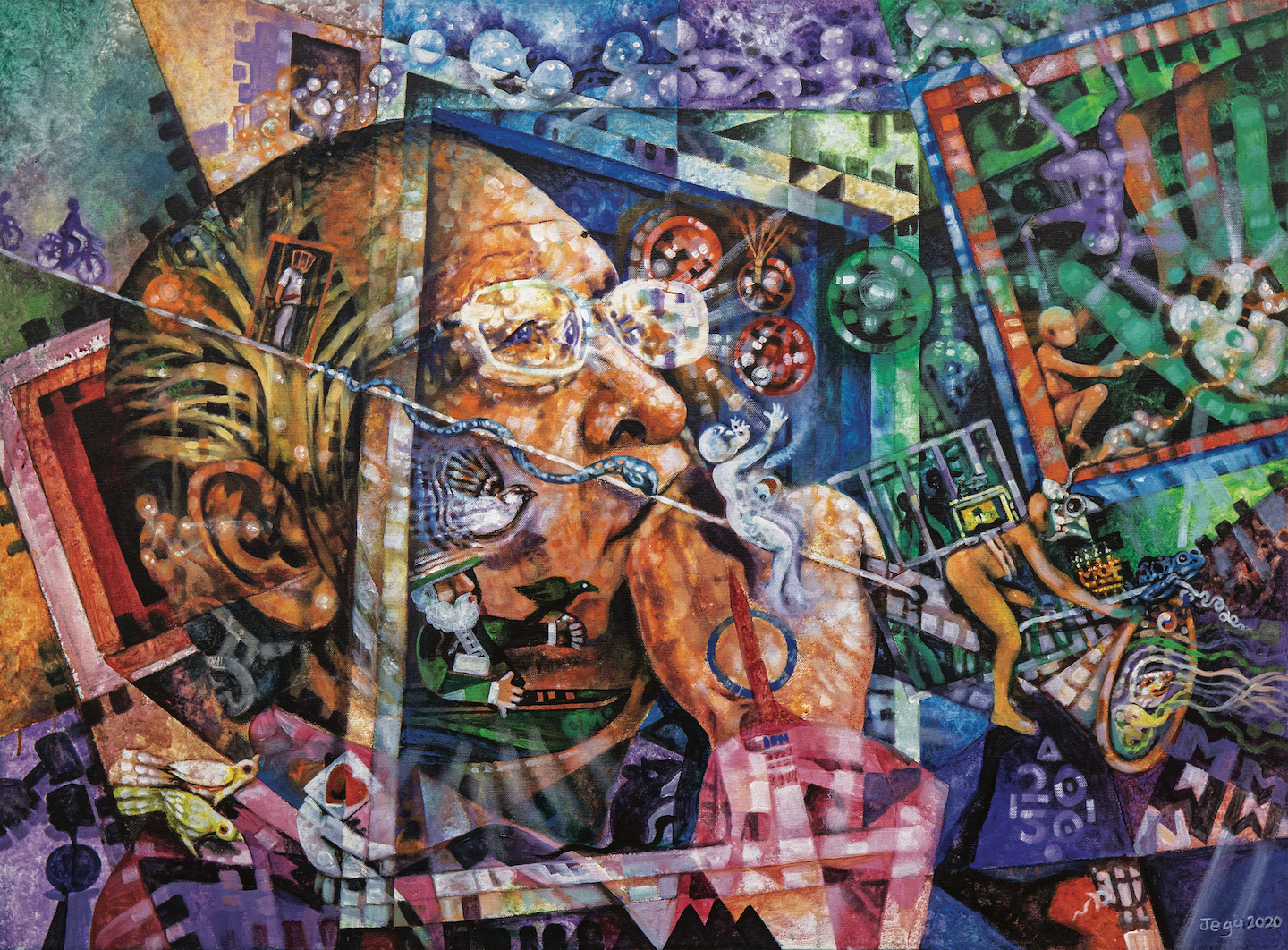
The exhibition opened at Theatre Impian, named in honour of Lim’s Malaysian Dream, on March 28 (Photo: Theatre Impian)
When Datuk Chan Kong Yew, the frontman for a new Kuala Lumpur gallery, approached Tony Pua with the idea of a visual art biography to celebrate Lim Kit Siang’s 80th birthday, the Damansara member of parliament took to it with gusto. After all, Lim was the man who, unknowingly, had seduced him into politics when Pua was a teenager.
So, in September 2018, he sat down with G13 Gallery curators Wendy Chang Chow Mei and Kenny Teng to draw up the storyboard and discuss who to commission with for Projek Siang. They decided on 80 artists — Lim turned 80 two months ago — and 100 works, to wish him longevity.
The exhibition opened at Theatre Impian, named in honour of Lim’s Malaysian Dream, on March 28. A book with details on each painting, sculpture, mixed media work and installation, as well as a 25,000-word biography on Lim, by Pua, was launched too. It follows the same focus as the permanent display: Lim’s origins, dreams and ideals, struggles and sacrifice, trailblazing years, hopes and triumphs, and his quest to build a better country for the people (a work in progress).
Pua says the main intent is for people, especially the younger generation, to get to know Lim better and “be inspired to do more and eventually take over from him”. Chang, who toasts Lim with an installation titled Yam Seng!, adds that the diverse spread of creativity, dynamism and talents portrays his life, struggles and achievements.
The project was collaborative and interactive, with the young and established artists from different races happy to be involved. While the curators decided who could best portray specific parts of the veteran politician’s story, Pua’s input was information on the Democratic Action Party (DAP), which Lim joined after its founding by Chen Man Hin in 1966. He subsequently became the first editor of The Rocket, the party newsletter.
The artworks, including one by Pua himself, reflect various facets of a man who dares to speak his mind and is often vilified for it through fake news, slander and outright lies; a bowed-but-not-broken politician for whom party and country come first, at the expense of personal freedom — Lim was detained twice without trial under the Internal Security Act 1960 (ISA). He took the blows and rolled with the punches because he believes the truth will prevail.
izwan1_blindfold.jpg
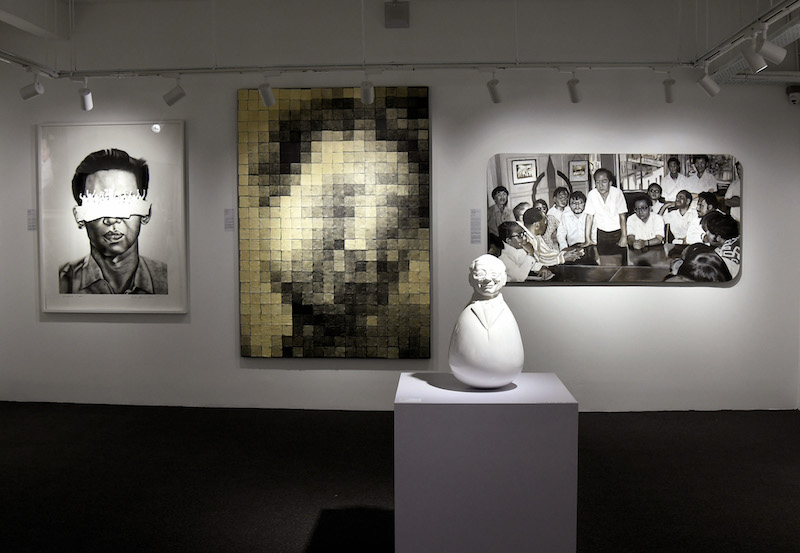
Visitors can follow Lim’s political evolution as he contested in different constituencies over more than five decades, starting with Serdang in 1968 and returning to Gelang Patah in his birth state of Johor in 2013. This “man of the people” walked the talk from dawn to dusk, meeting supporters at a breakfast ceramah and tugging at their heartstrings with his eloquence and zeal in villages and towns till long after lights out.
The late Jeganathan Ramachandram’s acrylic on canvas piece, Pied Piper, which graces the book cover, combines symbolic imageries that convey a visual narrative of Lim’s role as the proponent of the Malaysian Dream. Works under the “Origins” section show family portraits of Lim, the youngest of four siblings, and himself a father of four.
Batu Pahat High School was where he first stood up to unfair treatment, of students. Lim quit Form Six after some months and became a temporary English teacher at SJKC Senai. Then he joined The Straits Times in Singapore.
The family returned to Malaysia after Singapore’s separation and the seed of his political leanings took root. In 1960, he married Neo Yok Tee — they met in secondary school — and she became his emotional pillar as he rode the tides of politics. In Days of Future Past, Sherman Chu Seok Boon shows a clock in the night and young Neo waiting for her man.
Lim was vocal on issues of the day, from vernacular education and language to race, religion and a secular state, social democracy, multiculturalism, corruption, uneven playing fields and the question of who is a Malaysian. During the uproar over a three-page introduction to Jawi being included in a Bahasa Malaysia book to be used by Chinese vernacular schools, he revealed that he had taught himself Jawi during his first ISA detention in 1969 and it did not make him less of a Malaysian Chinese.
Demi Negara, Demi Rakyat, a unique piece of calligraphy by three artists, elegantly captures this message about integration and harmony.
Lim shaped alliances with leaders from other parties to work towards change and formed coalitions to advocate for clean and fair elections. Bersih 3.0: Stand Up!, an acrylic on leather piece by Chin Kong Yee, reflects a fisheye view of that battle.
Wise and far-sighted, especially as splinter factions started cropping up, he proposed the Anti-Hopping Act. He likened those who, after being elected on one party’s ticket, betrayed the people’s trust by switching to another, to “political frogs”, which “makes them very little different from con men”.
Calvin Chua’s watercolour on Lim running alongside Tiger of Jelutong Karpal Singh captures their vigour, enthusiasm and friendship. Many remember the Comrade-in-Arms walking in and out of courtrooms fighting to defend themselves and others against abuse of power by the state, Pua writes.
kit_siang.jpg
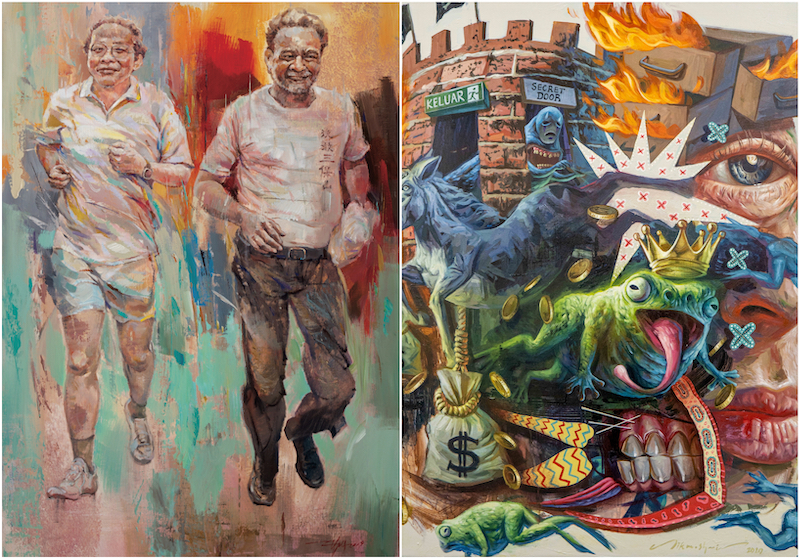
Lim plumbed emotional depths in his chequered career. His darkest moment was watching his son Guan Eng being handcuffed and taken to jail in 1998 for seeking justice for a 15-year-old girl involved in the case of statutory rape by a top Umno politician.
There were internal party crises too. DAP’s lowest point was losing in Penang in 1999. Lim considered retiring then but did not because “he had neither outlived his political usefulness nor outstayed his welcome in his party”.
Vindication was sweet when Pakatan Harapan toppled the old government on May 9, 2018; Lim never imagined he would live to see the day. The “New Malaysia” saw a fresh political landscape, with no single dominant coalition or party.
But the euphoria lasted only 22 months and things fell apart again when the backdoor government took over in February 2020. Now, Lim looks to the next generation to pick up the mantle and push towards his unwavering dream of democracy.
Beneath his superhero cape, Pua adds, “Uncle Lim” is a self-confessed introvert who gets tongue-tied when it comes to small talk. The former school librarian who read voraciously and has authored 38 books continues to pore over news reports and opinion pieces and write at least one statement a day. Happy to take a backseat now, the man who does not care for frills is comfortable eating in coffee shops and at hawker stalls. Lim’s only item of vanity is a plastic comb tucked into a back pocket, “to straighten any stray [hair] after catching forty winks on a road trip in a car”.
Still hopeful of a united Malaysia
DAP veteran Lim Kit Siang had no inkling of the permanent exhibition to celebrate his 80th birthday until he was invited to the preview three days before its launch. His initial reaction upon stepping into Theatre Impian was surprise, followed by feelings of being “overwhelmed and overawed”.
“I was surprised that there were so many items,” Lim says in a phone call with Options. Walking around the exhibits reminded him of his long political journey, with its ups and downs and successes and setbacks. “It has been a tough terrain.”
That the exhibition took more than two years to prepare speaks of a labour of love and solidarity. Most important of all, he adds, it reflects the idealism and common sharing of his Malaysian Dream — that of building a united, harmonious, democratic and progressive country where people can live together, whatever their race or religion.
“It’s a reminder that the dream has still to be realised. There is still a long journey ahead and what has been done must be continued.”
In sync with the final section of the display, titled A Work-in-Progress, the indefatigable Lim believes there is more to do yet. “There has been some regression but we must not give up hope. We must continue to dare to dream big dreams for the country. Everyone can contribute towards that in different ways.
“Yes, there have been setbacks in the last three years, but so long as we have the conviction, the perseverance and the stamina, we can still make it happen,” says the man Tony Pua describes as “simple but not a simpleton”.
demi_negara_demi_rakyat_61x91.5cm_ink_on_canvas_2020_mohd_zulfitri_mohd_sobri_tee_ying_jie_dr._vellu_perumal_1.jpg
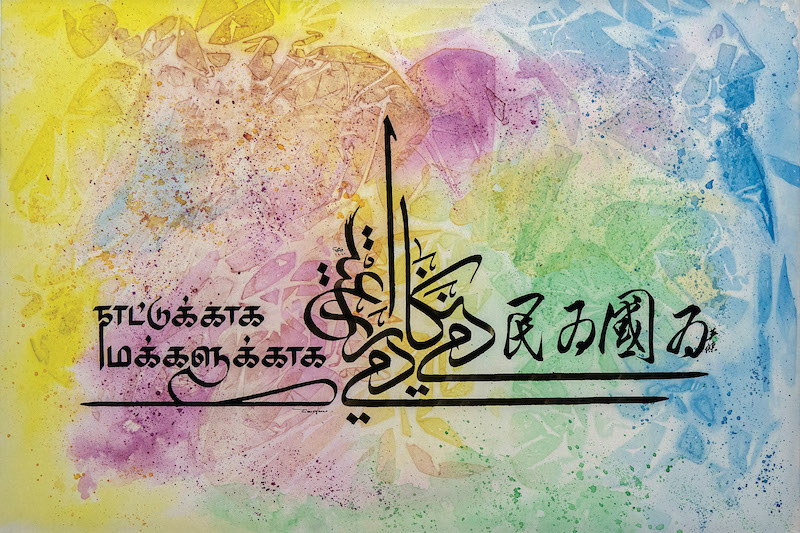
“If you had asked me before May 9, 2018, we never expected the results we had. Somehow, we never thought we were capable of achieving what we did during the 14th general election, even though we had slogged for it.”
Hope burns eternal in his stout heart, fanned by a deep-seated belief the country is worth fighting for. “After all, Malaysia is still not so bad a country. We do not want to be a nation that is incapable of its best.”
After 55 years with DAP, what he wants to do now is to “give new hope to Malaysians after the disappointments and dejection from the peak of May 2018. We must learn to live with ups and downs”.
Asked how he feels about being an octogenarian, Lim says: “Age is a number and I feel more concerned about the future than the past. The country must move towards greater unity and excellence.”
Having grandchildren — seven of them, aged 10 to under-30 — impresses upon him the need to soldier on. “Not for my sake because there’s nothing left for me, but for the sake of the younger generation and the nation, so they can see a better Malaysia, a better future.”
Lim hopes visitors to the exhibition will be “reenergised and remotivated to pursue the Malaysian dream. We don’t want the country to be divided and broken.”
Pua portrays the shenanigans at Sheraton
Two negative turns of events early last year led to something positive for Damansara member of parliament Tony Pua: He found time to paint something for the Theatre Impian tribute to Lim Kit Siang.
Pua had been asked by Projek Siang sponsor Datuk KY Chan, who knew he could draw, to contribute a piece. At that juncture, he was the political secretary to the then finance minister Lim Guan Eng and had weighty responsibilities.
The tumultuous Sheraton Move of Feb 23 toppled the Pakatan Harapan government and Pua got the boot too. Then MCO 1.0 came into force on March 18 and, suddenly, there was time to paint.
“The thing that moved deep in the head then was Langkah Sheraton. I thought a painting is a good way to put down my personal record of what took place. It became the most meaningful project to undertake for my time in isolation and solace.”
izwan6_tony_and_langkah_sheraton.jpg
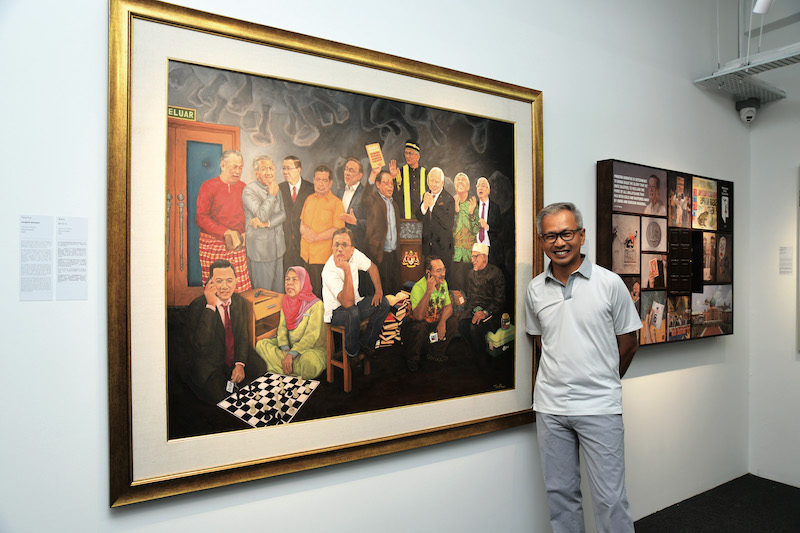
There is no message to his oil on canvas artwork, he adds, just a historical record of what happened that night and the key political players who “manoeuvred and out-manoeuvred each other in the attempt to secure majority control of the Malaysian Parliament”.
Pua places Langkah Sheraton in a pseudo-parliamentary setting, with Pakatan and Barisan Nasional representatives on opposite sides, and various figures hogging attention. He explains what he wants to depict.
“You have [Tan Sri] Muhyiddin [Yassin] trying to persuade Tun [Dr] Mahathir [Mohamad] to go with Umno and PAS and become the new PM with a new coalition. Guan Eng, on the PH side, is trying very hard to persuade Tun to stick to the party’s ideals and promises to the people.
“We know Tun didn’t listen to both sides; he had his own ideas and wanted to set up his own government. At the end of the day, Muhyiddin wanted betrayal, whether he was betraying the Pakatan coalition or Dr M himself.”
PKR deputy president Datuk Seri Mohamed Azmin Ali, who led a splinter faction of PKR, was “literally on his knees because he knew the main discussion then was whether Tun would hand over to [Datuk Seri] Anwar [Ibrahim]. If he did that, as he had promised to do, Azmin might be politically finished”. So, he is strategising his game to ensure political survival.
“Then, you have Kit Siang holding up the 2018 Buku Harapan election manifesto and reminding the coalition that, ‘We need to stick together. Whatever we do, the people voted for us and we must fulfil our promises, as much as we can’. But it was in vain.”
Datuk Seri Najib Razak and Datuk Seri Ahmad Zahid Hamidi are smiling and hopeful, because a change of government would mean they would no longer be prosecuted for corruption, Pua points out.
20210325_lei_lim_kit_siang_exhibition_6456_izw.jpg
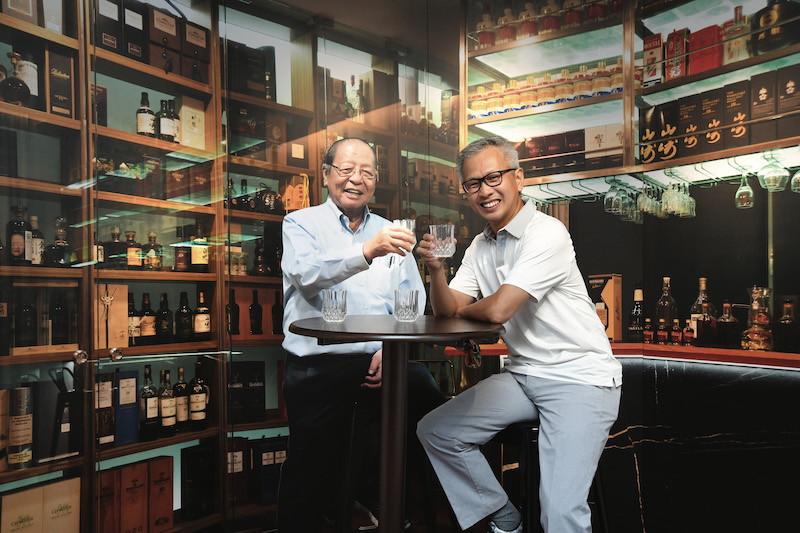
Others in the tableau include MCA president Datuk Seri Dr Wee Ka Siong, who appears curious about what is going on and wants in too, and PAS president Datuk Seri Abdul Hadi Awang, who sees no harm in a backdoor government and does not mind not being a minister because he can become a fisherman, Pua continues.
Datuk Seri Hishammuddin Hussein — “he’s a bit under the radar” — is squatting, dressed in cool holiday attire. A pensive Datuk Seri Mohd Shafie Apdal, the then Sabah chief minister and a former potential future PM, the artist explains, piques because no one knows what he is thinking.
Amid all this, the Dewan Rakyat Speaker is trying to control the House but no one seems to bother about him. Who is in charge? And hanging above the 15 heads is the coronavirus, a real and present danger until today.
Pua started working on Langkah Sheraton last March and finished it after 10 months. “The last time I did a proper painting was in Form Four. In school, I liked painting, backdrops and murals, and I know I can paint.”
But work got in the way of art and he never pursued it except for the two weeks in 2016, when he did a painting for Segambut MP Hannah Yeoh that raised RM50,000 for charity. “I was surprised.”
That piece, Shackled, Not Broken, was his way of showing he would not be bowed by the 1Malaysia Development Bhd defamation suit brought against him by Najib. Little people in the street trying to free a lone man from his shackles proves something: It is the people who make a difference.
The toughest thing for him when working on Langkah Sheraton was “learning and relearning because I hadn’t painted for very long. I was rusty, so I was slow. I made some mistakes and learnt along the way”. Working from left to right, he found the latter stage of his work was so much better and had to redo the earlier bits.
The good thing about oil is that after it dries, you can paint over it, Pua says. Initially unsure whether the Covid-19 idea would work, he decided to try first and change it if it did not. “It came out quite okay.” Nurturing a latent talent during the pandemic gets a nod too.
This article first appeared on Apr 5, 2021 in The Edge Malaysia.


